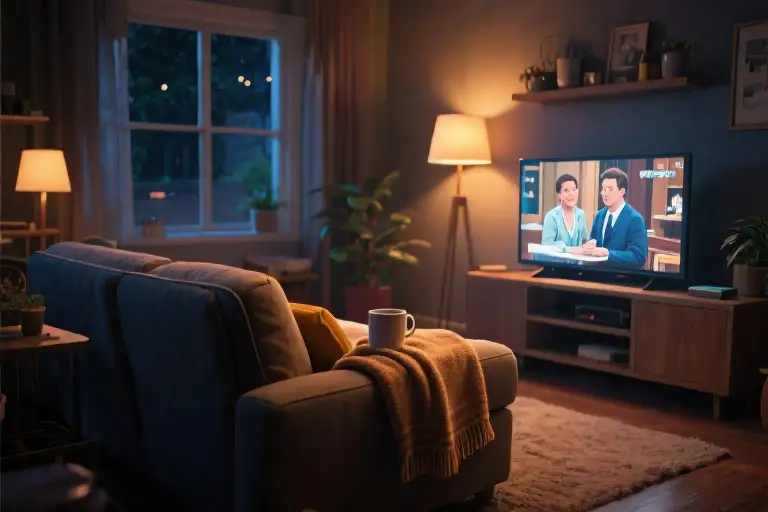The phone screen casts a pale glow at 3:17 AM. You’re curled into yourself like a misplaced comma, the kind of posture that makes ribs ache and lungs forget how to expand fully. Across the room, two types of love stand in stark contrast:
One reaches for you with words polished smooth by good intentions—”You’ll get through this,” “Let me fix it,” “Here’s what you should do…” Each syllable lands like a tiny hammer tapping at your fractures, well-meaning but insistent on reassembling you before you’ve finished falling apart.
The other says nothing. Just slides down the wall to sit beside you on the floor, shoulder pressing against yours with the steady warmth of a radiator in winter. Their silence isn’t empty; it’s the kind of quiet that holds space for your unspoken tremors, the sort that makes room for tears without demanding an explanation for each one.
This is the quiet rebellion against the cult of solutions we’ve been conditioned to expect from love. We’ve been handed scripts where love arrives with a toolbox—”I can change you,” “Let me make it better,” “You’d be happier if…”—as if tenderness were measured in repairs completed rather than wounds honored. But what if the deepest emotional support isn’t about fixing at all?
Research from the University of California shows that attempts to “solve” someone’s pain often increase cortisol levels by 23%, while silent companionship triggers oxytocin release. Our nervous systems recognize the difference between being managed and being met. That 3 AM moment exposes the lie we’ve swallowed: that love must always be active, always improving, always moving us toward some brighter version of ourselves.
Real emotional connection often looks like this:
- Fingers interlaced during a panic attack without instructions to “breathe properly”
- A shared blanket draped over shoulders when words feel like foreign objects
- Coffee placed silently on the nightstand after a sleepless dawn
These aren’t passive acts. They’re the active choice to say, through presence alone: Your unedited self is enough company for me. The kind of unconditional love that doesn’t need your sunshine to appreciate your rain.
As the light outside shifts from black to bruised purple, the person beside you finally speaks—not to break the silence, but to join it: “I don’t know either.” And suddenly, the weight feels different. Not gone, but shared. Not fixed, but witnessed. This is the paradox of silent companionship: by not trying to lift the burden, it makes the load lighter.
The Myth of Love as a Fixer
We live in a world that treats emotions like math problems waiting to be solved. When someone cries, we hand them tissues and platitudes. When they express doubt, we bombard them with motivational quotes. There’s an unspoken rule that love must come with a toolbox – that to care means to repair, to improve, to upgrade whatever seems broken in another person.
This mentality didn’t emerge from nowhere. Social media feeds bombard us with toxic positivity mantras: “Good vibes only” banners, “Choose happiness” coffee mugs, influencers preaching constant self-optimization. We’ve created what psychologists call “emotional capitalism” – where feelings get assigned market value (joy = premium, sadness = defective). A Harvard longitudinal study tracked two groups through grief – those pressured to “stay strong” showed 23% slower emotional recovery than those allowed to express vulnerability freely.
The consequences manifest in subtle ways. You apologize for crying during movies. You preface honest conversations with “Sorry to be a downer.” You measure your worth by how little space your darkness occupies in relationships. This cultural conditioning runs so deep that when someone simply sits with our pain instead of trying to erase it, we mistake their restraint for indifference.
Yet consider this: The body’s natural response to a wound isn’t immediate intervention. First comes stillness – the pause where blood vessels contract, where the organism assesses damage. Human emotions require the same respectful space. Real love understands that some fractures heal best when left to mend at their own rhythm, when witnessed without unsolicited sutures.
This explains why we remember certain moments with crystalline clarity: The friend who didn’t offer advice when you lost your job, just showed up with takeout and let you stare at the wall. The partner who, during your panic attack, didn’t say “calm down” but matched their breathing to yours. These interactions stick because they communicated the rarest modern reassurance: “You don’t need to perform wellness for me.”
Silent companionship operates on radical trust – the belief that people contain their own solutions, that presence alone can be methodology. It’s the antithesis of what Brené Brown calls “gold-plating grit” – our cultural obsession with turning every struggle into a teachable moment. Sometimes a heart doesn’t need lessons. It just needs company while it learns.
The Quiet Depths: Three Dimensions of True Presence
We’ve been conditioned to measure love by its volume—the grand gestures, the perfect advice, the relentless cheerleading. But the kind of companionship that actually heals often wears silence like a second skin. It operates in the unlit corners where words fail, where simply being becomes the most eloquent language of care.
Physical Presence: The Architecture of Solidarity
At a childhood friend’s funeral, I watched her father stand motionless by the casket for hours. He didn’t sob dramatically or deliver eulogies. He simply existed within the same unbearable air we were all breathing, his stillness creating a container for our collective grief. This is the first layer of true companionship—showing up bodily without agenda, allowing shared space to become sacred through mutual endurance.
Neuroscience confirms what our bones already know: mirror neurons fire whether we’re experiencing pain or witnessing it in someone we care about. When someone chooses to inhabit our painful space without flinching, their quiet presence literally helps regulate our nervous system. No pep talks required.
Emotional Attunement: The Unspoken Dialogue
My therapist once sat through seven minutes of my crying without offering a single platitude. ‘Your tears have their own wisdom,’ she finally said. ‘I’m just making sure they don’t have to fall alone.’ This second dimension—emotional synchrony—transforms companionship from passive attendance to active resonance.
Like the fox in The Little Prince who teaches the value of ‘taming’ through patient togetherness, emotionally attuned companions:
- Notice micro-shifts in your breathing patterns
- Match their posture to your emotional temperature
- Resist the urge to override your sadness with their optimism
Their silence isn’t empty; it’s charged with the kind of attention that makes you feel heard before you’ve spoken.
Purposelessness: The Gift of Unproductive Love
Modern relationships often resemble fix-it shops—we bring our broken parts to others expecting repairs. But the third and rarest dimension of true presence is its stubborn purposelessness. Like the friend who brought over takeout after my divorce and spent three hours listening to me rant, then said ‘I don’t have answers, but tomorrow’s taco Tuesday if you want to do this again.’
This quality defies our cultural obsession with measurable outcomes. It:
- Values connection over correction
- Prioritizes process over solutions
- Measures success in shared breaths rather than resolved issues
When you encounter this kind of love, you realize how many people have been listening to respond rather than to understand. The difference feels like switching from a fluorescent-lit office to candlelight—the same objects exist, but the shadows suddenly have permission to stay.
These layers build what psychologist John Gottman calls ’emotional hospitality’—the capacity to host someone’s unvarnished self without redecorating. Like trees growing around fence posts, such companionship doesn’t remove life’s obstructions but grows with them until the sharp edges become part of something organic and alive.
The Relationship Filter: 5 Signs of Authentic Companionship
We’ve all encountered those relationships where support feels conditional – the kind that demands you reassemble your broken pieces before receiving affection. But true emotional connection operates differently. It doesn’t require performance reviews or emotional labor audits. Here’s how to distinguish between surface-level sympathy and deep companionship.
Sign 1: Comfort With Silent Spaces
Watch how they navigate your quiet moments. Authentic companions don’t rush to fill emotional silences with platitudes or forced humor. Their body language remains open when you stop speaking mid-sentence. They might mirror your posture or breathing rhythm, creating wordless synchrony. Contrast this with those who nervously chatter about the weather when tears pool in your eyes, their discomfort with raw emotion revealing transactional intentions.
Sign 2: The Architecture of Their Questions
Listen to their sentence structures. “How are you feeling?” lands differently than “Why do you feel that way?” The former creates space for exploration; the latter demands justification. Psychological safety research confirms that open-ended emotional inquiries (“What’s that experience like for you?”) activate different neural pathways than analytical probing. Someone invested in your wellbeing will instinctively use feeling-focused language, their questions acting as doors rather than interrogations.
Sign 3: Emotional Endurance
Notice their stamina during your low tides. Temporary supporters tap out when your struggle exceeds inspirational movie duration. Real companions measure time differently – they’ll sit through three consecutive nights of your existential spirals without glancing at their watch. Their patience isn’t performative; you’ll catch them remembering specific details from your darkest monologues months later.
Sign 4: The Gift of Undivided Attention
Observe their device habits when you’re vulnerable. The modern litmus test of care: can they set aside their phone without visible withdrawal symptoms? Authentic presence manifests physically – leaning in rather than leaning back, maintaining eye contact during your shaky confessions. These micro-behaviors reveal more about emotional availability than grand gestures ever could.
Sign 5: Aftercare Rituals
Study their follow-through. Surface-level comforters vanish when the heavy lifting begins, their support ending with the conversation. True companions check in after the storm passes – the text asking if you ate today, the spontaneous delivery of your comfort food. Their care has continuity, demonstrating understanding that emotional recovery isn’t linear.
These patterns form an invisible curriculum in the school of unconditional love. While no single interaction proves everything, repeated demonstrations create a relational fingerprint. The most telling indicator? After being with them, you feel neither fixed nor broken – simply held. That’s the quiet magic of silent companionship no self-help book can manufacture.
The Art of Silent Support: Practicing Non-Intervention Love
We’ve all been there—that moment when someone shares their pain, and our first instinct is to grab our mental toolbox. We scramble for solutions, advice, anything to make it better. But what if the most powerful form of love isn’t about fixing at all?
The 10-Minute Solution-Free Conversation
Try this experiment with someone you care about: Set a timer for ten minutes where your only job is to listen without offering a single piece of advice. No “you should…”, no “have you tried…”, just presence. You’ll notice something remarkable—when we stop trying to repair people, we create space for their authentic selves to emerge.
This isn’t passive listening. It’s active restraint. Your silence becomes a container strong enough to hold their unedited emotions. Watch what happens when someone realizes they don’t need to perform recovery for your benefit. That’s when real healing begins.
Emotional Weather Reports
Instead of analyzing why it’s raining in someone’s heart, try simply naming the weather. A soft observation like “You seem like afternoon thunder rolling in” does something magical—it validates without interpreting. This practice comes from emotion-focused therapy techniques, stripped down to its poetic essentials.
When we label emotions this way:
- We avoid the trap of false positivity (“It’ll get better!”)
- We bypass the interrogation (“Why do you feel that way?”)
- We simply acknowledge the emotional landscape as it exists
True emotional support isn’t about being the sun that chases away someone’s rain—it’s about being the person who brings an umbrella and walks beside them through the storm. The kind of love that heals isn’t loud with solutions; it’s quiet with understanding.
These practices aren’t about doing nothing. They’re about doing the hardest thing of all—resisting our urge to control the emotional process of those we love. In that restraint, we offer something rare: the freedom to be imperfectly, messily human.
The Quietest Love That Holds You Longest
Some loves don’t come with instruction manuals or repair kits. They don’t arrive with flashy promises to ‘make everything better’ or blueprints for your personal renovation. The deepest love often wears silence like a second skin, learning the braille of your unspoken pains before you’ve formed the words.
When your voice fractures into a thousand unshed tears, this love doesn’t reach for superglue. It cups its hands beneath the cracks and whispers, ‘I’ve got you.’ No sermons about positive thinking. No impatient glances at their watch while waiting for you to ‘snap out of it.’ Just two humans sitting in the tender mess of being alive—one heart saying to another: your broken pieces are still worthy of company.
We’ve been conditioned to believe love should perform miracles—transform sadness into joy, weakness into strength, chaos into order. But the quiet revolutionaries of affection know better. They understand that healing begins when someone stops trying to rearrange your pain and instead makes space for it at the dinner table. Their greatest gift isn’t solutions, but presence; not fixing, but fitting themselves around your jagged edges without complaint.
Unconditional love isn’t a spotlight that demands you sparkle. It’s the gentle nightlight allowing you to breathe through the dark. Notice how the people who truly see you never ask you to hold your shadows at arm’s length. When you whisper ‘I’m not okay,’ they don’t panic or proselytize. They simply pull up a chair to your exhaustion and say, ‘Then let’s be not-okay together for a while.’
This is how you recognize emotional support that nourishes rather than depletes: it asks nothing of your wounds except permission to sit beside them. No forced optimism. No rushed timelines. Just the sacred arithmetic of two heartbeats synchronizing in the dark.
So here’s to the lovers who don’t flinch from tears, the friends who brave the monsoon seasons of your soul, the rare companions who understand that sometimes ‘I don’t know what to say’ is the most eloquent love poem of all. May we find them. May we become them. And may we finally believe we’re deserving of love that doesn’t always speak in exclamation points.
Your turn: When has someone’s quiet presence healed you more than words ever could? → #TheQuietThatHoldsUs





